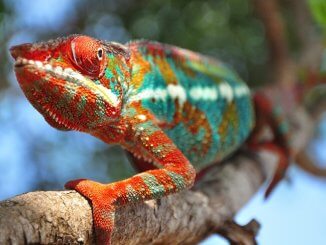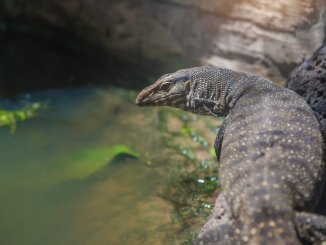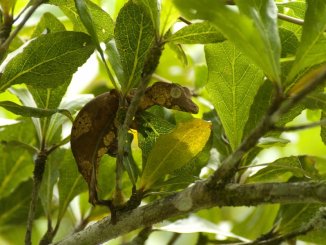The chahoua gecko is a medium-sized arboreal lizard native to the region of New Caledonia. These reptiles are recognized by their large white lidless eyes with vertically oriented pupils, triangular heads, and strong muscular tails. Chahoua geckos range in color based on geographic variation and can be anywhere between brick red and brown to dark green and gray shades.
The chahoua gecko is fairly easy to care for, which makes the animal an excellent pet for a beginner owner. These creatures are tranquil and intelligent, as well as can get used to humans quickly.
Chahoua Gecko Overview
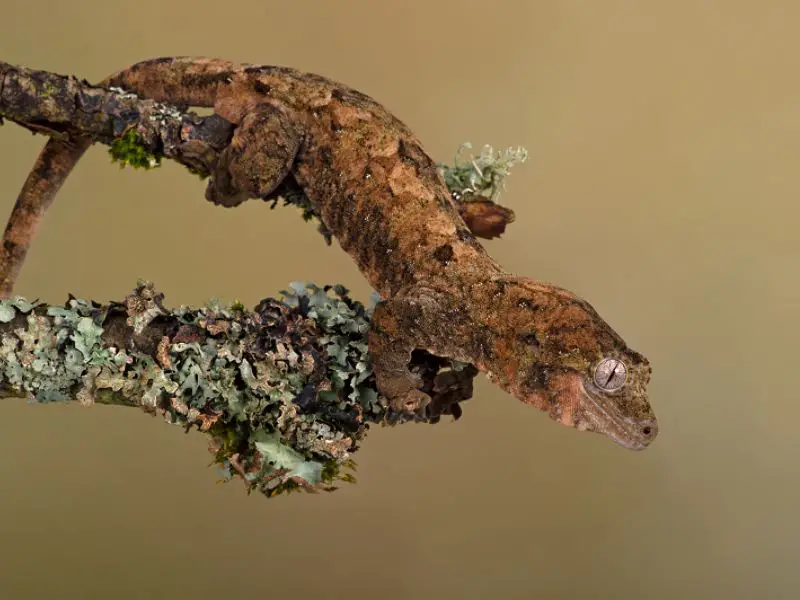
| Common name | Chahoua gecko, mossy New Caledonian gecko |
| Scientific name | Mniarogekko chahouai |
| Natural habitat | Tropical forests of New Caledonia |
| Adult size | 10–12 inches |
| Average lifespan | 10–12 inches |
| Diet | Omnivores |
| Housing | Terrarium |
| Experience | Beginner |
Origin
The chahoua gecko (Mniarogekko chahoua) originates from a collective of islands in the southwest Pacific Ocean, a territory administered by the French authorities. Chahoua geckos are the most likely to inhabit the tropical forests of the main island in the region, Grande Terre, as well as the Isle of Pines.
Chahoua geckos are arboreal creatures which means they live on trees in dense forests of New Caledonia. These reptiles’ natural habitat is represented by high temperatures and intense humidity.
These lizards are currently recognized as Vulnerable animals by the International Union for Conservation of Nature (IUCN) Red List and are not commonly found in the wild. However, they are quite common in captive trade.
Appearance and Behavior
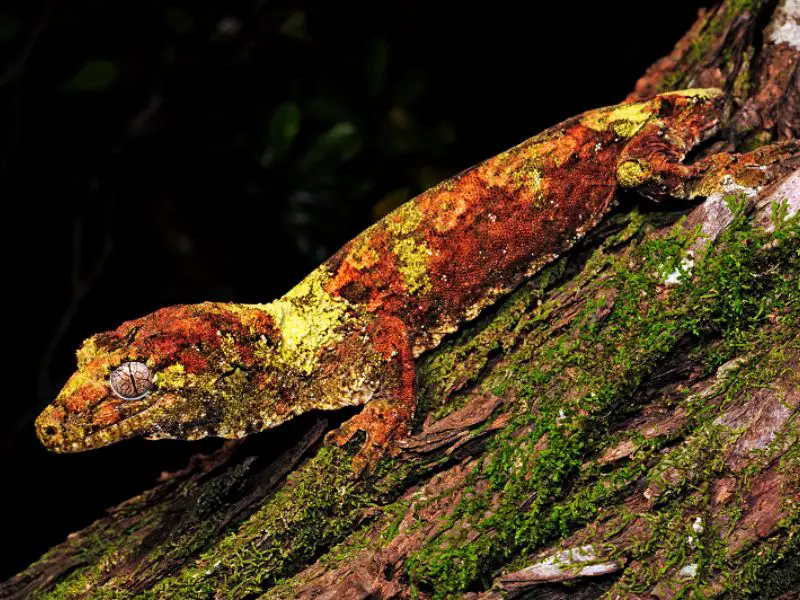
The chahoua gecko is a medium-sized lizard recognized by its unique body shape and coloration. The lizard has a massive triangular head with large eyes with their distinct light color and vertical pupils. The chahoua gecko has a strong elongated body with a muscular tail.
Chahoua geckos vary in coloration, which is thought to be affected by geographic variation in New Caledonia. Experts suggest that the species living on the outer islands of the region may display lighter gray patterns more often. Other common colors for chahoua geckos include dark red, green, brown, and white.
Male and female chahoua geckos are almost identical in their appearance. It is impossible to distinguish the sex of the animal until maturity. Then, a male chahoua gecko develops a bulge between the legs, while a female doesn’t.
Size and Lifespan
Chahoua geckos typically reach 10 to 12 inches in length. Additionally, their length from snout to vent is around 5.5 inches. These geckos have long muscular tails that do not drop like it’s common for many other geckos in the moment of danger. When chahoua geckos hatch, they are as small as 1 ½–2 inches long.
When given proper care, chahoua geckos can live in captivity for up to 20 years. The exact lifespan of the species in the wilderness is unknown.
Temperament
The chahoua gecko is a calm and intelligent species that gets used well to the human presence. They don’t get overly stressed while being handled, but it’s best to keep touching these animals to a minimum.
Chahoua geckos are less active species compared to other geckos, but they still need a lot of hiding and climbing space in the enclosure due to their size. These lizards are nocturnal creatures that are most active during the night.
Chahoua geckos can get aggressive and territorial when housed together, which is why it’s best to keep these lizards separate unless planning to breed them.
Housing Chahoua Gecko
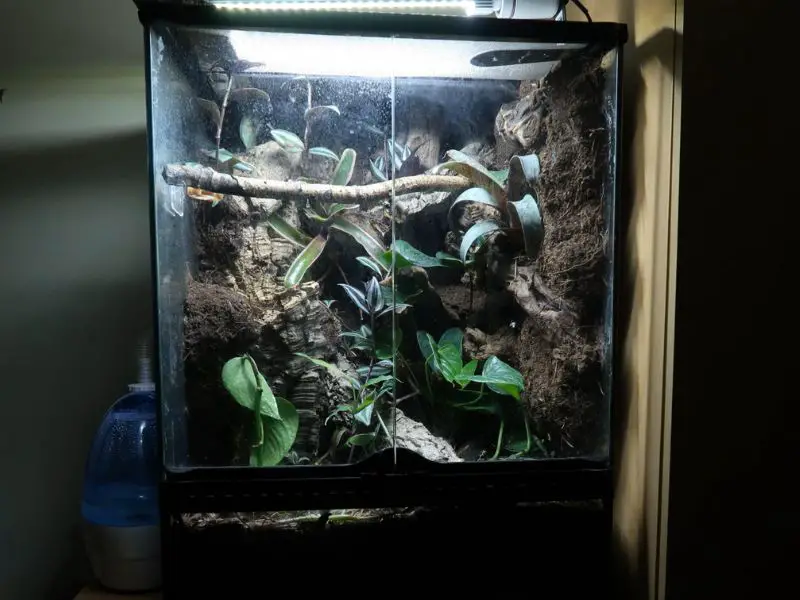
The chahoua gecko is native to the warm and humid tropical forests of New Caledonia, which should be reflected on its housing in captivity. For this reason, the gecko requires a stable temperature in the enclosure, as well as a high level of humidity. The lack of proper conditions in the terrarium may negatively affect the reptile’s health.
Enclosure size
The best type of enclosure for a chahoua gecko is a functional terrarium. Compared to other geckos, chahoua geckos are much larger, which means they need a tank that is large enough for them to move around, hunt, and hide. Because they are arboreal creatures, chahoua geckos need some elevation in the terrarium enabling them to climb.
Select a tall terrarium that has some extra height. The appropriate dimensions for the chahoua gecko tank are 36 inches long, 18 inches wide, and 36 inches high.
Keep in mind that baby chahoua geckos need a smaller enclosure while they grow because they can get stressed when kept in a tank with too much space, making them feel vulnerable to threats. A good enclosure size for a younger chahoua gecko is 12 inches long, 12 inches wide, and 12 inches high.
Lighting
Chahoua geckos are nocturnal creatures, which means they are mainly active at night. To maintain a high level of vitamin D3 which is crucial for the reptile’s health, the gecko would benefit from a UVB light, but one is not necessary for these lizards. Installing a functional UVB light mimics the day-and-night cycle.
Place a UVB lamp on the same side of the terrarium as the heat lamp. Make sure to put the lamp inside of the tank, as UVB light doesn’t come through glass or plastic. Lamps should be turned on for 12 hours a day and switched off for the night completely. It’s also best to change the UVB lamps every six to 12 months.
Temperature and Humidity
Because chahoua geckos are nocturnal creatures, they do well in lower temperatures. These reptiles need a variety of temperatures in the enclosure to successfully regulate their body temperature.
Chahoua geckos are comfortable in day temperatures between 78°F and 82°F, but the lizards also need a hotter basking area and a cooler area, mimicking the temperature changes in their natural habitat. The temperature of the basking area should be kept between 82°F and 85°F, but should not go above 86°F.
It’s best to use a basking bulb to provide the gecko with the necessary warm spot in the enclosure. The lamp should be close to a plant or a wooden branch, on which the gecko could climb, to mimic their natural habitat conditions. The cooler zone in the terrarium should be between 65°F and 72°F.
The chahoua gecko also requires a high level of humidity in the enclosure. The average level of humidity for these geckos is between 60% and 80%. Humidity should be monitored with a hygrometer. To maintain an appropriate level of humidity, it’s best to mist the terrarium twice a day. In addition, provide the reptile with a water bowl which will also contribute to stable humidity levels in the tank.
Substrate and Decoration
While chahoua geckos are arboreal creatures that don’t spend a lot of time on the ground, they still need a high-quality substrate which will help retain the humidity levels, as well as provide a soft bedding for the gecko once it jumps on the ground. The best substrate for the chahoua gecko should be made of half organic topsoil, half of coconut fiber. The substrate should be at least two inches deep.
Cleaning
Clean the chahoua gecko terrarium should be cleaned once every day by wiping the walls of the enclosure using a mild cleaning solution and removing any litter. The terrarium should also be cleaned completely twice a month.
To clean the tank, remove the gecko and place it into an old terrarium so that it doesn’t escape. Take out and disinfect the decorations in the tank, which can be done either by putting them in a dishwasher or boiling them in water for 30 minutes. Use a non-toxic disinfectant to spray and wipe the walls of the enclosure and make sure no solution is left on the surfaces after the cleaning is complete.
Make sure to change the substrate once every 3 months.
Chahoua Gecko Care
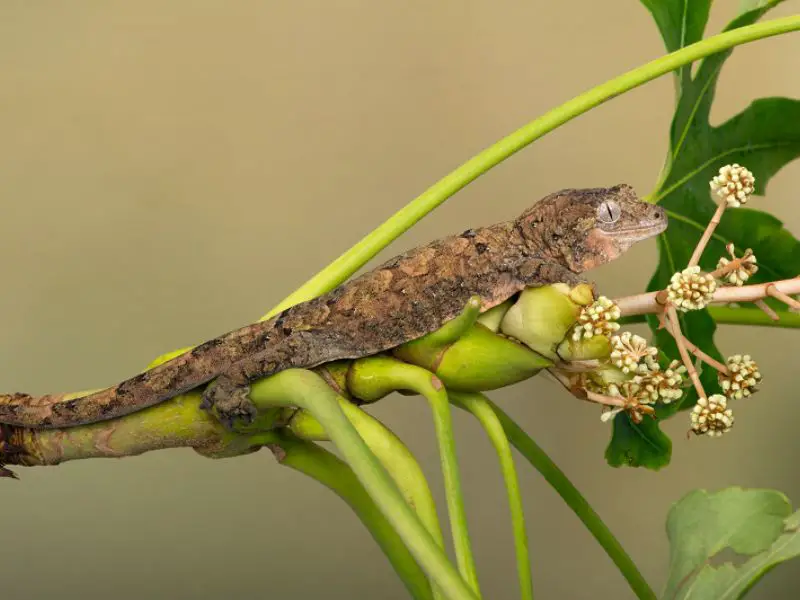
The chahoua gecko is a pet that’s relatively easy to take care of. These reptiles are hardy and don’t have a lot of requirements when it comes to feeding, and they get used to handling quite well.
Food and Water
Chahoua geckos are omnivores, so they need both plant-based and animal-based foods in their diet to get all the necessary nutrients. These lizards tend to eat fruit and insects in the wild. In captivity, 50% of their diet can be live insects, and the other 50% – the specially made crested gecko diet (CGD).
Young chahoua geckos aged between 0 and 12 months should be fed daily and given insects once every few days. Adult geckos should be fed three to four times a week and given insects every other day.
Chahoua geckos sometimes lick the water drops that appear as a result of condensation on the walls of the terrarium. However, these reptiles also need a separate water bowl placed in the enclosure to drink from. Change water in the bowl every day and make sure to disinfect the bowl every week to prevent any health issues from poor hygiene.
Handling
Chahoua geckos are known to be intelligent reptiles that get used to human touch well. The gecko should not be handled straight away when it’s brought home. The owner should wait for two weeks to allow the pet to adjust to the new conditions and start feeling comfortable in the enclosure.
After the adjustment period is over, the owner can slowly start introducing themselves to the gecko by putting their hand inside of the tank for a minute or so. This should be done during the night when the gecko is active.
This way, the lizard can get used to the owner’s scent and overall human presence. After another week or so, start handling the gecko for a few minutes a few times a week, increasing the time of handling as seems appropriate.
When handling the gecko, move slowly and make sure to not touch it by the tail, because it can come off. Make sure to stay close to the ground or the bed if the gecko starts acting frantically or tries to jump.
Common Health Issues
The chahoua gecko is a generally healthy reptile that rarely experiences health problems, if taken care of properly.
Chahoua geckos, like many other reptiles, tend to suffer from the metabolic bone disease (MBD) if they suffer from a calcium deficiency. The symptoms of MBD include libs twitching, uncharacteristic bumps on the reptile’s body, or a deformed tail.
MBD in chahoua geckos can be prevented by exposing the lizard to enough UVB light so that it synthesizes vitamin D3, or by giving it vitamin D3 and calcium supplements.
Another common health issue for chahoua geckos is parasites, which is also prevalent among other pet reptiles. The geckos can catch mites that look like small red or black bugs moving around the reptile’s eyes.
Chahoua geckos can rarely have mites when already in the tank unless they already had them before getting home. If mites are noticed on the gecko, take the pet to the exotic veterinarian to find the right treatment.
Chahoua geckos can be vulnerable to intestinal impactions which happens when too much substrate is swallowed by the lizard. Symptoms may include lack of appetite and constipation. When the symptoms are noticed, take the gecko to the vet as soon as possible for treatment.
Breeding
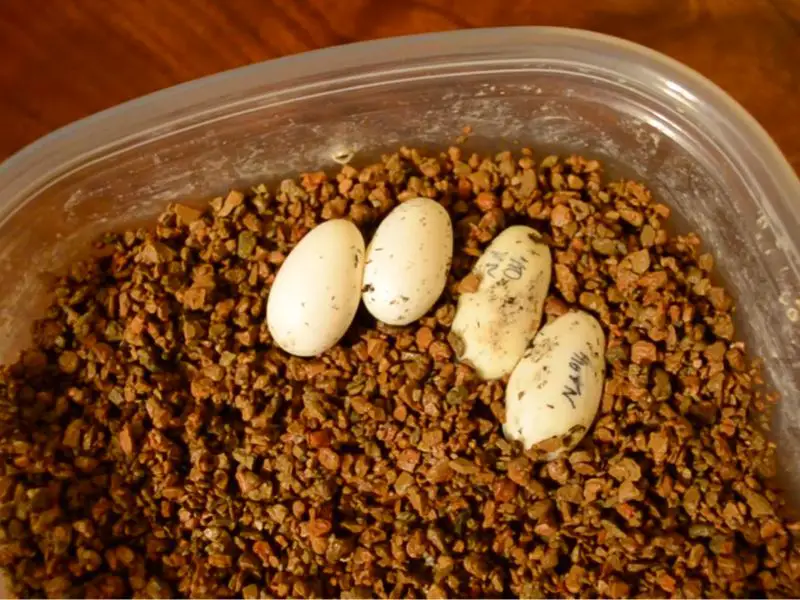
Chahoua geckos are one of the hardest reptiles to breed in captivity. Female chahoua geckos become mature at the age of two, and males – at the age of 18 months. Until the reptiles are mature, it’s best to keep them separate.
When the male and female are placed in the terrarium to mate, make sure both reptiles are fed well and have the right conditions closely matching the environment of their natural habitat. During mating, the male chahoua gecko will mount the female, biting the flesh on her neck.
The female chahoua gecko will lay eggs 30–35 days after mating. Chahoua geckos don’t usually bury their eggs but tend to hide them in the most concealed place they can find. When the eggs are found, extract them carefully, making sure they stay in the same position as they lay, because changing their positioning may hurt the embryo. It’s best to mark the top side of the egg with a pencil or a pen to make sure the correct position is preserved.
The eggs should be incubated at a temperature of 80°F, and the substrate should be kept hydrated. The eggs can take anywhere between 70 and 200 days to hatch. The baby geckos should be taken out of the incubation container and placed in a small terrarium with damp paper towels on the bottom.
Choosing and Buying a Chahoua Gecko
The chahoua gecko is an expensive reptile because of how rare it is in the wild and how difficult it is to breed. A chahoua gecko can cost around $1,000. The gecko can be found online, as well as at some of the biggest trade shows or exotic pets exhibitions.
When choosing a chahoua gecko, make sure to consider factors such as the breeder’s reputation, the age of the lizard, as well as how it looks. The best chance to get a healthy gecko is to find a good breeder.
Make sure to see the gecko with your own eyes before ordering it online, because the reptile may have some health issues that would be difficult to see on a photo. Check the lizard for mites, unusual deformities, as well as make sure its eyes are clear and the pet is not lethargic.

